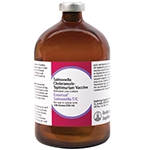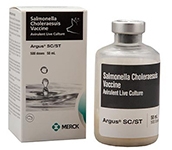Salmonella Infection in Pigs

While there are roughly 2,500 different Salmonella strains (called serovars/serotypes) that can cause issues for humans and animals, only a small number of those strains cause severe disease in pigs.
Because each serovar affects herds differently, various treatment protocols exist. When dealing with Salmonella, using the correct diagnostic test is critical to accurately determine the source and the strain which results in deployment of the proper corrective measures.
Salmonella bacteria multiplies mainly in the intestines of young growing pigs but can also be found in sows and finisher pigs. The bacteria may be shed in feces for several weeks or months with no clinical disease. Among the traditional enteric diseases affecting pigs today, Salmonella is one of the most widespread and resilient to treatment measures.
The bacteria can colonize and survive in any organism, from plants to insects to animals and with its ability to adapt to new environments, Salmonella can survive even the most uninhabitable conditions making it impossible to eradicate.
Infections caused by Salmonella can present in one of two ways: clinical or subclinical. The clinical signs most often present as diarrhea or septicemia. However, subclinical Salmonella is the more common presentation and problem experienced by the majority of herds.
Salmonella choleraesuis and Salmonella typhimurium serovars need to be treated with extra care, and diagnostic tests are often the first step to ensuring the disease doesn’t spread further than it has to. Of these serovars, the one to pay closest attention to is Salmonella Typhimurium, one of the most common zoonotic (disease causing in humans) strains found on swine farms today. Salmonella Typhimurium in the gut of the pig can contaminate carcasses during the slaughter process resulting in potential public health risks from food poisoning.
Signs & Symptoms of Salmonella
-
In growing pigs...
-
The acute septicemia and pneumonia which may occur with S. choleraesuis may result in fever, inappetence, respiratory distress, depression, coughing, red skin and poor doing pigs.
-
The skin of the extremities (i.e. tail, ears, nose and feet) become blue.
-
Foul-smelling watery diarrhea which may be blood stained.
-
Yellow jaundice may result from liver damage and lameness from arthritis.
-
Nervous signs resulting from meningitis.
-
If untreated, mortality may be high.
-
In sows...
-
A high temperature.
-
Depression.
-
Loss of appetite.
-
Congestion of the ears, snout and tail.
-
Pneumonia.
-
Coughing.
-
Nervous signs.
-
A smelly sometimes bloody diarrhea.
-
Death may occur in the acute phase of the disease.
How Salmonella is Transmitted
-
Exposing pigs to other pigs or boots, clothing, or equipment that have been around other pigs greatly increases the risk for disease transmission.
-
Fecal-oral is the primary route of transmission between pigs.
Preventing Salmonella Infections in Swine
The best way to minimize Salmonella infections is to vaccinate. Vaccination programs need to be modified to each swine operation and should be developed in consultation with your veterinarian.
Enterisol Salmonella T/C

The first dual antigen swine Salmonella vaccine with early age use - 2 weeks of age.
Convenient oral delivery.
Easy on pigs and people.
PQA friendly – no needles.
Argus SC/ST

Proven protection against BOTH Salmonella choleraesuis and Salmonella typhimurium.
Patented gene deletions remain stable after in vitro and in vivo backpassages.
Effectively controls pneumonia, diarrhea, septicemia and mortality caused by Salmonella choleraesuis.
Effectively controls disease and shedding of Salmonella typhimurium.
Argus SC/ST is recommended for use in pigs 3 weeks of age and older.
Treating Salmonella Infections in Swine
Florcon 2.3% Antimicrobial Concentrate

Florcon is a synthetic broad-spectrum antibiotic for the treatment of swine respiratory disease.
Effectively combats Antinobacillus pleuropneumoniae, Pasteurella multocida, Salmonella choleraesuis, and streptococcus suis in swine.
Treatment is only through drinking water.
It's important to contact your veterinarian to determine the best vaccination program for your site. If you have any questions concerning treatment and prevention of Salmonella in swine, please contact Pipestone Veterinarian Services by calling 507-562-PIGS(7447).
